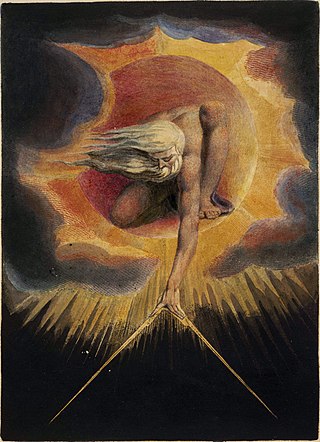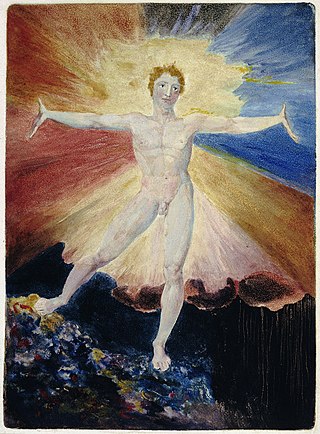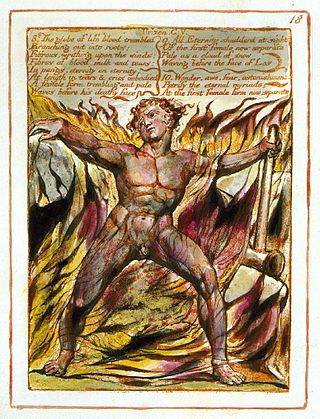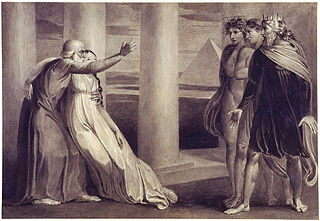Related Research Articles

In the mythology of William Blake, Urizen is the embodiment of conventional reason and law. He is usually depicted as a bearded old man; he sometimes bears architect's tools, to create and constrain the universe; or nets, with which he ensnares people in webs of law and conventional society. Originally, Urizen represented one half of a two-part system, with him representing reason and Los, his opposition, representing imagination. In Blake's reworking of his mythic system, Urizen is one of the four Zoas that result from the division of the primordial man, Albion, and he continues to represent reason. He has an Emanation, or paired female equivalent, Ahania, who stands for Pleasure. In Blake's myth, Urizen is joined by many daughters with three representing aspects of the body. He is also joined by many sons, with four representing the four elements. These sons join in rebellion against their father but are later united in the Last Judgment. In many of Blake's books, Urizen is seen with four books that represent the various laws that he places upon humanity.
The prophetic books of the English poet and artist William Blake contain an invented mythology, in which Blake worked to encode his spiritual and political ideas into a prophecy for a new age. This desire to recreate the cosmos is the heart of his work and his psychology. His myths often described the struggle between enlightenment and free love on the one hand, and restrictive education and morals on the other.

Orc is a proper name for one of the characters in the complex mythology of William Blake. A fallen figure, Orc is the embodiment of rebellion, and stands opposed to Urizen, the embodiment of tradition.

In the mythology of William Blake, Albion is the primeval man whose fall and division results in the Four Zoas: Urizen, Tharmas, Luvah/Orc and Urthona/Los. The name derives from the ancient and mythological name of Britain, Albion.

Jerusalem, subtitled The Emanation of the Giant Albion, is a prophetic book by English poet William Blake. Jerusalem is the last, longest and greatest in scope of Blake's works. Etched in handwriting, accompanied by small sketches, marginal figures and huge full-plate illustrations, it has been described as "visionary theatre". The poet himself believed it was his masterpiece and it has been said that "of all Blake's illuminated epics, this is by far the most public and accessible". Nonetheless, only six copies were printed in Blake's lifetime and the book, like all of Blake's prophetic works, was all but ignored by his contemporaries.

Ahania is the Emanation, or female counterpart, of Urizen, Zoas of reason, in William Blake's mythology. She is the representation of pleasure and the desire for intelligence. Although Urizen casts her out as being the manifestation of sin, she is actually an essential component in Blake's system to achieving Divine Wisdom. She is a figure of the goddess of wisdom. It is through her that the sons and daughters of Urizen are born. In the original myth, her son Fuzon rebels against his father and is responsible for separating Urizen and Ahania. In his later version, Ahania is separated from Urizen after he believes that she is sinful.

The prophetic books of the 18th-century English poet and artist William Blake are a series of lengthy, interrelated poetic works drawing upon Blake's own personal mythology. They have been described as forming "what is in proportion to its merits the least read body of poetry in the English language". While Blake worked as a commercial illustrator, these books were ones that he produced, with his own engravings, as an extended and largely private project.

Enitharmon is a major female character in William Blake's mythology, playing a main part in some of his prophetic books. She is, but not directly, an aspect of the male Urthona, one of the Four Zoas. She is in fact the Emanation of Los, also male. There is a complex verbal nexus attached. The Zoa Tharmas has emanation Enion, and Eni-tharm(as)-on is one derivation of her name. That should perhaps be read in the inverse direction though, as a construction of the Tharmas/Enion pair's names. Within Blake's myth, she represents female domination and sexual restraints that limit the artistic imagination. She, with Los, gives birth to various children, including Orc.

In the mythological writings of William Blake, Luvah is one of the four Zoas, who were created when Albion, the primordial man, was divided fourfold. He represents love, passion, and rebellious energy. His Emanation is Vala; his fallen form is Orc. Throughout Blake's mythological system, he is opposed to Urizen, the representation of reason. He is also connected to Jesus, who takes upon his form as the being of love after Luvah falls and turns to a being of hate.
In the mythological writings of William Blake, Urthona is one of the four Zoas, who were created when Albion, the primordial man, was divided fourfold. Specifically, he is the Zoa of inspiration and creativity, and he is a blacksmith god. His female counterpart is Enitharmon. Urthona usually appears in his "fallen" form, that of Los.

The Spectre is one aspect of the fourfold nature of the human psyche along with Humanity, Emanation and Shadow that William Blake used to explore his spiritual mythology throughout his poetry and art. As one of Blake's elements of the psyche, Spectre takes on symbolic meaning when referred to throughout his poems. According to professor Joseph Hogan, "Spectre functions to define individuals from others [...] When it is separated [from Emanation], it is reason, trying to define everything in terms of unchanging essences." Thus, according to Samuel Foster Damon, Spectre epitomizes "Reason separated from humanity" and "Self-centered selfhood" or, as Alexander S. Gourlay puts it, Spectre is "characterized by self-defensive rationalization".
Tiriel is the eponymous character in a poem by William Blake written c.1789, and considered the first of his prophetic books. The character of Tiriel is often interpreted as a foreshadowing of Urizen, representative of conventionality and conformity, and one of the major characters in Blake's as yet unrealised mythological system.

In the mythological writings of William Blake, Los is the fallen form of Urthona, one of the four Zoas. He is referred to as the "eternal prophet" and creates the visionary city of Golgonooza. Los is regularly described as a smith, beating with his hammer on a forge, which is metaphorically connected to the beating of the human heart. The bellows of his forge are the human lungs. Los's emanation, Enitharmon, represents spiritual beauty and embodies pity, but at the same time creates the spatial aspect of the fallen world, weaving bodies for men and creating sexual strife through her insistence upon chastity. In the Book of Urizen (1794), Los and Enitharmon have a child, Orc, who is the embodiment of the spirit of revolution. The name Los is, by common critical acceptance, an anagram of Sol, the Latin word for "sun". Los is also the plural form of El, an ancient Hebrew deity. Such innovations are common in many of Blake's prophetic poems.

Tiriel is a narrative poem by William Blake, written c.1789. Considered the first of his prophetic books, it is also the first poem in which Blake used free septenaries, which he would go on to use in much of his later verse. Tiriel was unpublished during Blake's lifetime and remained so until 1874, when it appeared in William Michael Rossetti's Poetical Works of William Blake. Although Blake did not engrave the poem, he did make twelve sepia drawings to accompany the rough and unfinished manuscript, although three of them are considered lost as they have not been traced since 1863.
Leutha is a female character appearing in the mythology of William Blake. According to S. Foster Damon, A Blake Dictionary, she stands for 'sex under law'.

Vala, or The Four Zoas is one of the uncompleted prophetic books by the English poet William Blake, begun in 1797. The eponymous main characters of the book are the Four Zoas, who were created by the fall of Albion in Blake's mythology. It consists of nine books, referred to as "nights". These outline the interactions of the Zoas, their fallen forms and their Emanations. Blake intended the book to be a summation of his mythic universe but, dissatisfied, he abandoned the effort in 1807, leaving the poem in a rough draft and its engraving unfinished. The text of the poem was first published, with only a small portion of the accompanying illustrations, in 1893, by the Irish poet W. B. Yeats and his collaborator, the English writer and poet Edwin John Ellis, in their three-volume book The Works of William Blake.
In the mythological writings of William Blake, Vala is an Emanation/mate of Luvah, one of the four Zoas, who were created when Albion, the primordial man, was divided fourfold. She represents nature while Luvah represents emotions. Originally with Luvah, she joins with Albion and begets the Zoa Urizen. In her fallen aspect, she is the wandering figure known as the Shadowy Female. After the Final Judgment, she is reunited with Luvah but placed under the dominion of the restored Urizen.
In the mythological writings of William Blake, Enion is an Emanation/mate of Tharmas, one of the four Zoas, who were created when Albion, the primordial man, was divided fourfold. She represents sexuality and sexual urges while Tharmas represents sensation. In her fallen aspect, she is a wailing woman that is filled with jealousy. After the Final Judgment, she is reunited with Tharmas and able to experience an idealised sexual union.
Golgonooza is a mythical city in the work of William Blake. Golgonooza is a City of Imagination built by Los, the spiritual Four-fold London, a vision of London and also linked to Jerusalem and is Blake's great city of art and science.
In William Blake's mythology, Beulah, originally Hebrew בְּעוּלָה, is "the realm of the Subconscious, the source of poetic inspiration and of dreams." It is also, according to Blake scholar Alexander S. Gourlay, "a dreamy paradise where the sexes, though divided, blissfully converse in shameless selflessness. Beulah is available through dreams and visions to those in Ulro, the utterly fallen world." Between Eternity and Ulro, it is imagined as a place without conflict similar to a conventional image of heaven or Eternity. However, for Blake, the idea of an everlasting peaceful Eternity is misguided and fallen.
References
- Erdman (1952). "Blake's Vision of Slavery". Journal of the Warburg and Courtauld Institutes. 15 (3/4): 242–252. doi:10.2307/750476. JSTOR 750476. S2CID 195035256.
- Aers (1977). "William Blake and the Dialectics of Sex". ELH. 44 (3): 500–514. doi:10.2307/2872570. JSTOR 2872570.